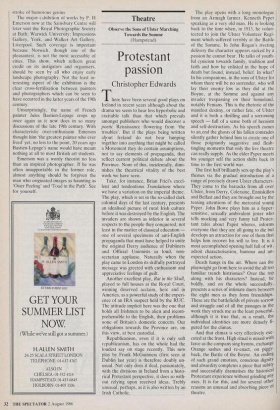Exhibitions
Twenty for Today: New Portrait Photography (National Portrait Gallery till 25 August)
Life and Landscape: P. H. Emerson — Art and Photography in East Anglia 1885-1900 (Sainsbury Centre for Visual Arts, Norwich, till 26 October)
Glossy or matt?
Giles Auty
Reviewing the paintings of war artist Eric Kennington 18 months ago, I sug- gested that the faces of the soldiers he drew from the first world war 'had an inner strength and purpose rarely if ever seen in our own increasingly disillusioned times'. This thought returned while looking at an Fxhibition of photography this week when It struck me that it may often be the character of the sitters, rather than simple nostalgia, which gives old photographs such widespread appeal. By contrast with the turn of the century Photographs by P. H. Emerson at the Sainsbury Centre for Visual Arts in Nor- wich, Twenty for Today, at the National Portrait Gallery, assembles the talents of a score of sophisticated, youngish photo- graphers who are about to do for Britain, SO the catalogue introduction tells us, much of what David Bailey, Donovan and Duffy apparently achieved in the 1960s.
. No doubt such a claim is intended to Impress but it fills me with foreboding. Only in the past few years have I finally been reassured to learn that .1 was not altogether alone in my limited enthusiasm for many of the cultural and social impera- tives of the 1960s, References which put that era forward as some kind of Golden Age will appeal strongly only to those who were too young to know, incurable roman- tics or that loyal band capable of watching the films of Richard Lester without anaes- thesia.
Unlike P. H. Emerson who, in essence, was a wealthy and opinionated amateur, many of the young photographers on show at the National Portrait Gallery are simply skilled commercial photographers out to make fame and fortune in the worlds of fashion, glossy periodicals and advertising. Whether the National Portrait Gallery is the right place to see some of this work seems open to query. This is not a question of misplaced aesthetic snobbery but of motivation. Technical skill, of which there is plenty in evidence, is not, in itself, any guarantee of artistic pedigree. To add further gloss, through portraiture, to repu- tations which may be largely fabrications of the media in the first place, should not be seen as the sole, unquestioning aim of the genuine artist/photographer. Glamorising still further the faces of the already famous presupposes a certain naive belief in the figures so presented. To do so is the antithesis of worthwhile portraiture and ranks, for all its superficial seductive- ness, with the most boring of boardroom portrait painting. Thus the male singer Marilyn, presented by photographer John- ny Rosza in androgynous deshabille has, if anyone stops to think, much in common with some weirdly benign boararoom rendering of a biscuit manufacturer. Good portraiture stems from observation rather than obsequiousness and can aid its view- ers better understand the world they in- habit. 'Portrait of Marilyn Shaving' is possibly more the kind of resolute image one had in mind.
It was no surprise to learn that the work of many of these young photographers is to be found more usually in the pages of Vogue, Harpers & Queen, Ritz and so forth. I do not cavil at the necessity for this nor at the artistic skills in many of the offerings. Those who wish to see Melvyn Bragg, Len Deighton, J. P. Donleavy, Simon Le Bon, Bruce Oldfield, Richard Rogers, Greta Scacchi, Michael Winner et al portrayed pretty much how they see themselves need look no further. On the other hand, I thoroughly enjoyed the portraits by Robert Barber, who manages to convince me that Tim Roth, Clare Park and Phoebe Nicholls are people with whom interesting conversations might be possi- ble. Stephen Hyde, great grandson of P. H. Emerson, achieves much the same in his outstanding portrait of Sir John Sum- merson. Dudley Reed's idea of showing Ricardo Bofill, architect of water-bound buildings, as a quizzical amphibian is a stroke of humorous genius.
The major eAhibition of works by P. H Emerson now at the Sainsbury Centre will later visit the Royal Photographic Society at Bath; Warwick University; Impressions Gallery, York, and Walker Art Gallery, Liverpool. Such coverage is important because Norwich, though one of the pleasantest, is not the most accessible of cities. This show, which reflects great credit on its instigators and organisers, should be seen by all who enjoy early landscape photography. Not the least in- teresting aspect of the exhibition is the clear cross-fertilisation between painters and photographers which can be seen to have occurred in the latter years of the 19th century.
Unsurprisingly, the name of French painter Jules Bastien-Lepage crops up once again as it now does in so many discussions of the late 19th century. With characteristic over-enthusiasm Emerson thought him 'the greatest painter who ever lived' yet, no less to the point, 20 years ago Bastien-Lepage's name would have meant nothing at all to most British art students.
Emerson was a wordy theorist no less than an inspired photographer. If he was often insupportable in the former role, almost anything should be forgiven the man who originated images as haunting as 'Osier Peeling' and 'Toad in the Path'. See for yourself.











































 Previous page
Previous page